Early Spring Lawn Care
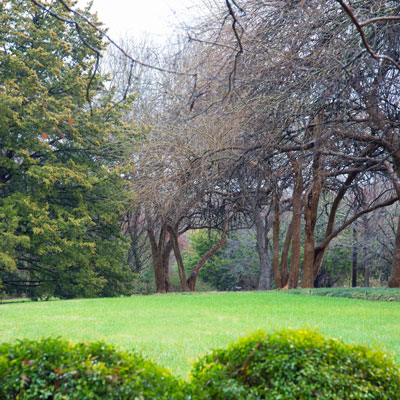
Our lawns typically start their spring surge even earlier than trees and most shrubs. (This is overseeded ryegrass in bermuda.)
Things begin to move in fast-forward as temperatures climb. Nowhere is it more evident than with our lawns. Grass is beginning to green, in fact, lawns in South Texas never went brown.
But the most noticeable signs of life in our lawns come from the weeds. Suddenly they’ve gone from little tufts of green to giant, trip-you-in-the-dark clumps of ugliness.
So that’s our starting point, and your goal is to have a highly respectable, or if you prefer to use the word, “beautiful” home lawn by later this spring and early summer. How do you get there?
Mr. Roadmap here, and I’ll outline your journey. It could be a long trip, so I’ll hit the major points of interest.
(This will be a somewhat more detailed story than we’ll usually have here in e-gardens, but since 32 percent of the calls to my radio programs over 38 years have dealt with lawn questions, the interest dictates the space.)
The journey starts here.
1. Our first step is optional. Many people like to begin the growing season by scalping their lawns to remove browned stubble left over from the winter. That same scalping also eliminates henbit and several other weakly growing types of weeds. But unless you were mowing your lawn higher than the recommended height, scalping is a choice that isn’t essential. It certainly is messy, so wear a high-quality respirator and goggles.
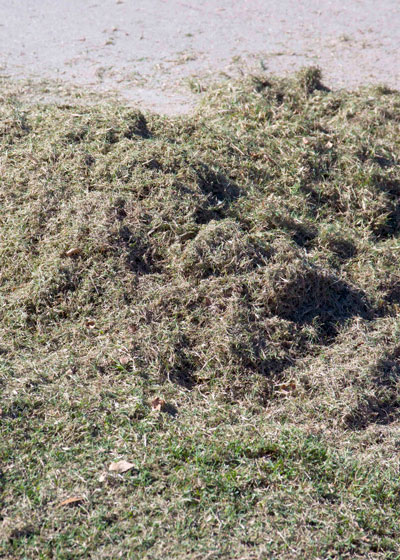
Scalping involves lowering the mower one or two notches and removing browned stubble. It is messy, and it’s primarily aesthetic – certainly not required.
2. Apply a broadleafed weedkiller spray to control existing dandelions, clover, chickweed and other weeds that aren’t grasses (“broadleafed”). There are dozens of brands of broadleafed weedkillers on the market. Let your local fulltime nursery professional show you the options. Almost all will contain an active ingredient called by its shorter name, “2,4-D.” These sprays are not fast-acting. Allow 10 to 14 days for them to do their work. Do not mow for a few days before or after you apply them. Read and follow label directions carefully for best results.
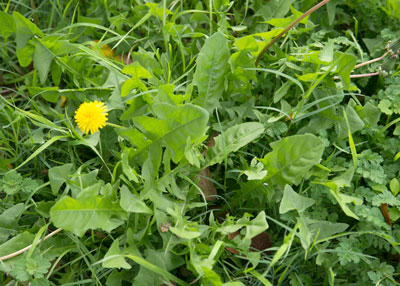
Obviously not grasses, these bold broadleafed weeds can be controlled with a herbicide spray containing 2,4-D.
3. There is no spray that will kill existing weedy grasses such as annual bluegrass, rescuegrass and ryegrass. They are all cool-season weeds, which means the way to prevent them is to apply a pre-emergent herbicide (Team, Dimension or Halts) between August 25 and September 7. Once you can see these weeds starting to grow, it’s too late to prevent them.
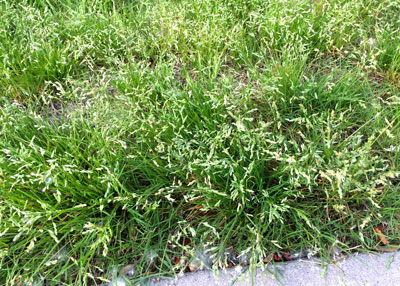
This is an unusually bad stand of annual bluegrass in a lawn. There is no control for it once it is growing. Apply a pre-emergent to stop the next generation. Timing is critical: first week of September.
4. However, if crabgrass and grassburs have been trademarks of your summer lawn in years past, apply any one of those pre-emergent granules now (Central and North Central Texas) and in a week or two (far North Texas). You will also need to repeat the treatments in 90 days for a full season of control. As with the others, your only hope of eliminating them is preventing them before they start growing. There is no way to kill them as growing weeds without killing your desirable lawngrass.
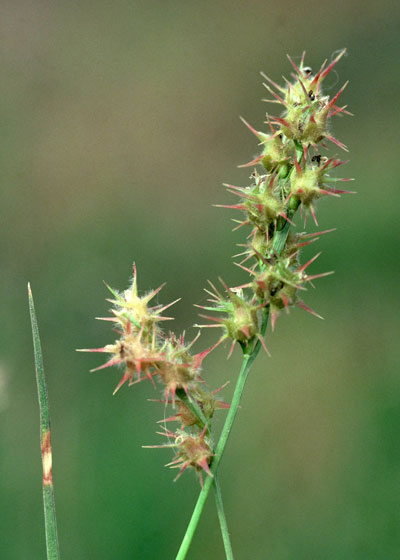
Grassburs must be prevented by use of pre-emergent weedkiller applied in late February or March and repeated 90 days later.
_________________________________________________________________________________
This spot in our journey would equate to the average date of the last killing freeze in your area. What we listed above would be done two to three weeks prior to that date. What we list below would follow that date. If you have my latest book, there are maps showing those dates, or you can easily find them online. You need to know that date for your area.
5. Fertilize your lawn with the best plant food product you can find, and do so two to four weeks after the last freeze date. That doesn’t necessarily mean the most expensive fertilizer or the one that receives the most hoopla on TV. You want a high-nitrogen or, for most parts of Texas, an all-nitrogen fertilizer that has half or more of its nitrogen in slow-release or encapsulated form. It will all be listed in the fine print on the back of the bag. Have your nursery professional interpret it for you. Once learned, never forgotten.
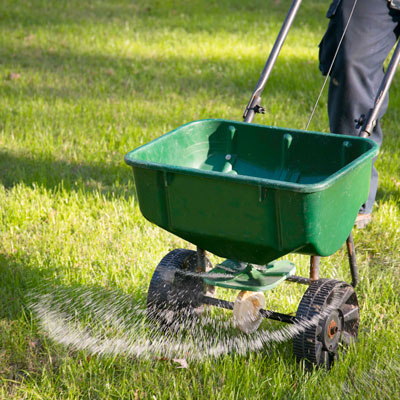
Apply fertilizer in two passes over the lawn, one going N/S and the other going E/W. That will provide more uniform coverage.
“Weed-and-feed” note here: Have you noticed that I have not recommended application of a weed-and-feed combination? That’s because the weedkiller treatments came several weeks before that average date of the last killing freeze, and the tip to fertilize says you should do so two to four weeks after. I believe in fertilizing our lawns, and I believe in applying weedkillers, but just as I don’t believe in texting and driving, other things should be done at appropriate times, too.
6. Mow your lawn at the recommended height to encourage low and dense growth. Letting grass grow tall weakens it and makes it more vulnerable to weed invasion. Mow frequently for best results.
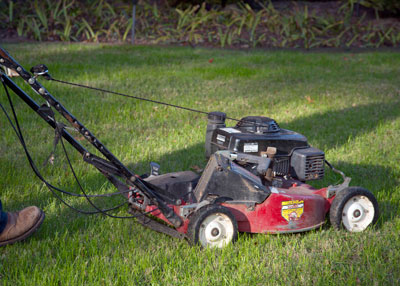
Mow regularly, and at the recommended height.
7. If you have uneven spots in your lawn, April is the best time to fill them. I use brick sand, just like you’d put in a sandbox. I let it dry on my driveway, then I shovel it in and filter through the existing grass to even out the soil surface. If the low areas are deeper than an inch or so, you may need to bring in weed-free topsoil, perhaps from another part of your yard.
8. “Thatch” is an undecomposed accumulation of organic matter, primarily grass blades and stems, that have formed a thick mat on top of the soil’s surface and beneath the runners. It’s as tough as fiberboard and impenetrable to water and nutrients. It’s not very common, but if you do have it (usually with hybrid bermudas), your grass will be slow to green up and unresponsive to fertilizer and water. Vertical core aeration is your best way of breaking through the thatch, and April is your best time to do so.
9. Speaking of watering, your grass may need supplemental irrigation if you get a few days of warm, windy weather. While we all need to conserve water for the future Texas droughts that we’ll surely encounter, don’t overdo things and let your grass flounder. Have a reason for watering, then water carefully. If you have a sprinkler system, have your irrigation contractor put it through an irrigation audit to check for wasted water.
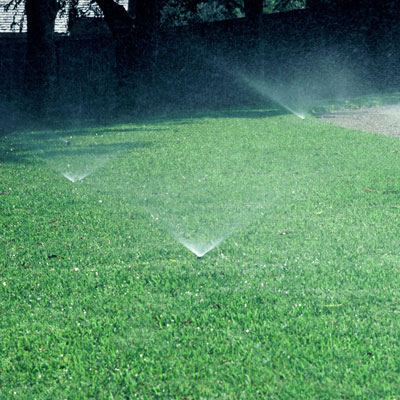
Be sure sprinklers are functioning properly. Water only as grass shows signs of need. Keep your landscape and lawn healthy, but conserve every possible drop.
10. Finally, in our details of early spring lawn care, I’ll take you up to the point of getting new grass started. That’s a task for late April and May in most of the state (late March and April along the Gulf Coast and in Deep South Texas. Don’t rush this job, however, because you’ll be planting “warm-season” grasses (do most of their growing while it’s hot), and the soil won’t be warm enough for them until then.
So I’ll wait for you here on our journey as you get caught up to speed. Another time soon we’ll talk about choosing the best lawngrass, what to do when grass won’t grow in the shade, spring and summer insects and diseases that bother turf, and more. That will be in upcoming weeks and months.
